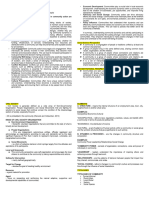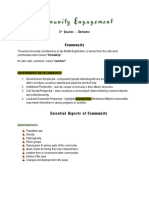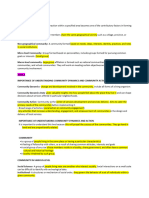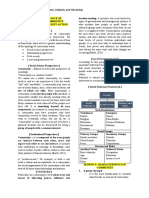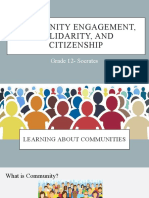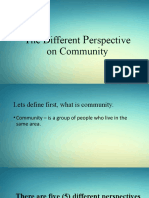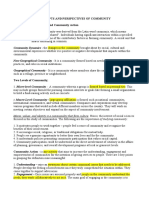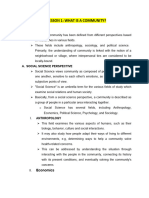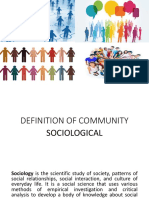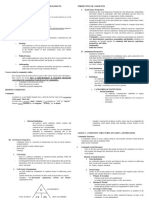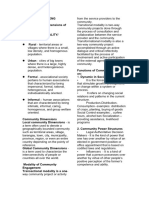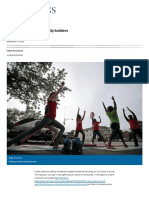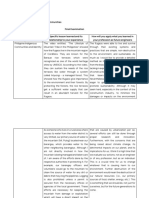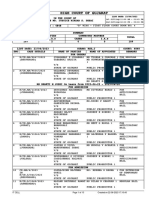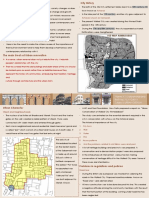COMMUNITY, ENGAGEMENT, SOLIDARITY AND CITIZENSHIP
CONCEPT AND PERSPECTIVE OF COMMUNITY
LEARNING ABOUT THE COMMUNITIES
* The key to appreciate our daily interactions with others, as we locate ourself in a web of social connections.
* Knowing the range of reasons why people come together, why they form relationship, and bonds, and how these
operate in the broader social setting makes us further appreciate the value of the meaningful actions and contributions
that we impart to our community.
*understand the dynamics within our community aids us in responding to the collective challenges we face.
* Addressing this challenges through community initiatives and interventions requires a familiarity of the community-
people, history, issues.
Disciplines in the Social Sciences
vis-à-vis communities.
1. Sociology: looks into the group formations, relationships, dynamics, and interactions within a social structure,
and social action.
2. Political Science: draws attention to issues and problems related to public affairs, consensus building, and the
dimensions of power vis-à-vis the allocation and distribution of resources and values.
3. Anthropology: Helps examine the emergent complexities from the history and culture of individuals and
community.
Community- was derived from the Latin word communitas which means “fellowship”. Its Latin roots, communis, means
“common”. Com translates to “with” or “together” whereas munire translates to “to strengthen,” “to fortify” or “to
defend”.
Definition of community using a Social Science perspective
* An informally organized social entity, characterized by a sense of identity.
* A group of people living in the same defined area, sharing common basic values, organization and interest.
* A Population which is geographically focused existing as a unique social entity with a collective identity and purpose,
and
* A group of people with diverse characteristics, linked by social ties, formed and consolidated by their collective
aspirations, sharing and exchanging perspective, and are collectively engaged to do so some concerted action in a
geographical location or setting.
CIVIL SOCIETY PERSPECTIVE
Civil Society this refers to a political community of original groups operating within the authoritative parameters of the
state.
It has also been referred to as a third sector, distinct from the State (government) and the market (business)
Example:
Non-governmental organization
People’s Organization
Organic perspective
- refers to a local or grassroots group within a particular locale that are driven and organized because of community
issues and concerned.
- they are referred to as “grassroots” because of their local and capacity-building characteristics.
- it is generally conceptualized as the formation of neighborhood organizations, rural or urban, covered to pursue local
development goals or address particularly issues, such as crime prevention, environment protection, or waste
management.
ORGANIC PERSPECTIVE
- Grassroots communities are able to strengthen their sense of community as they work together in pursuing an
identified task or goal.
- Grassroots organizations or movements are typically composed of volunteers from local/community level.
- Grassroots organizations and movements have also been instrumental in political party formation.
��TYPES OF COMMUNITIES
1. Urban Community
• Includes cities
• There are lot of people close together in a small amount of space
• There is not much open space on natural areas
2. Rural Communities
• Called the country composed of farm lands.
• Areas are more open spaces and lots compared to urban areas.
• Number of people is much fewer than urban areas.
3. Suburban Communities
• Are usually close to, but not in cities. There are fewer people than on urban communities, but many more than in
rural communities.
• Houses are often in neighborhood and many people have yards.
• There are many natural areas.
4. Slum
• Is a highly populated urban residential area consisting mostly of closely packed, decrepit housing units in a
situation of deteriorated or incomplete infrastructure, inhabited primarily by impoverished person.
Community Dynamics
- it is the process of change, growth, and development in communities involving all of its members. It gives us an
understanding of the community’s needs, members involvements and decision making social network, services, and
policies present and needed for the continues progress of the community.
-The dynamics of community are deteremined by its nature and structure and how it reacts with external or internal
forces.
Nature of Community
1. A community is a sociological construct
Sociological construct or a set of interactions or human behaviors that have meaning and expectations between its
members. There is not just action but actions based on shared expectations, values, beliefs and meaning between
individuals.
2. A community has Fuzzy boundaries
- when a community is little village separated by a few kilometers from other villages in a rural area, its boundaries
appear at first to be very simple. The human interaction present may be seen as consisting only of relations among the
residents living inside the village.
-If the resident interacts with people outside the village, they may, for example, marry persons from other places and
move or bring a spouse in to live with them. At any given time, those village residents may have sisters, brothers,
cousins, parents, and relatives living elsewhere. The boundary of the community is no longer that precise.
3. A community can exist within a larger communities, including district, regions, ethics groups, nations, and other
boundaries. Their maybe marriage and other interactions that link the villages of a nation together.
4. A community may move
* When technology is not based on local horticulture, the community residents may be physically mobile. They may be
nomadic herders walking long distances with their cattle. They may be mobile fishing groups who move from time to
time to where the fish are available. They may be hunters who move to follow the game.




